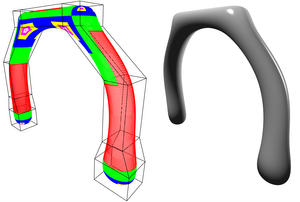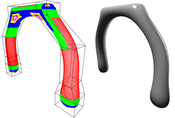Information
- Publication Type: Bachelor Thesis
- Workgroup(s)/Project(s):
- Date: 2013
- Date (Start): 15. May 2013
- Date (End): 30. September 2013
- Matrikelnummer: 0928004
- First Supervisor: Przemyslaw Musialski
- Keywords: subdivision surfaces, geometric modeling, GPU tessellation, computer graphics
Abstract
Catmull-Clark subdivision is a powerful standard modeling technique and has already been used extensively in CGI for motion pictures or computer games. An artist creates a coarse polygon mesh, that is computationally converted into a high-quality smooth surface. Due to the recursive nature of the subdivision algorithm and the large number of polygons, that are generated during the mesh-refinement, it is not well suited for realtime-environments. There exist several approaches to generate a Catmull-Clark subdivision surface which use current GPU technologies to overcome these issues.In this thesis, we use Compute Shaders for subdivision and a Cubic Bezier Patch which takes advantage of the tessellation pipeline to get an optimized algorithm without the loss of visual quality. With the presented method, the support of (Semi)Sharp Creases, which are an important feature to achieve a more realistic look, is also given. The practical part of this thesis is integrated into the Helix 3D Toolkit SharpDX Framework.
Additional Files and Images
Weblinks
No further information available.BibTeX
@bachelorsthesis{koessler-2013-BA,
title = "Feature-Adaptive Catmull-Clark Subdivision on the GPU",
author = "Christian K\"{o}{\ss}ler",
year = "2013",
abstract = "Catmull-Clark subdivision is a powerful standard modeling
technique and has already been used extensively in CGI for
motion pictures or computer games. An artist creates a
coarse polygon mesh, that is computationally converted into
a high-quality smooth surface. Due to the recursive nature
of the subdivision algorithm and the large number of
polygons, that are generated during the mesh-refinement, it
is not well suited for realtime-environments. There exist
several approaches to generate a Catmull-Clark subdivision
surface which use current GPU technologies to overcome these
issues. In this thesis, we use Compute Shaders for
subdivision and a Cubic Bezier Patch which takes advantage
of the tessellation pipeline to get an optimized algorithm
without the loss of visual quality. With the presented
method, the support of (Semi)Sharp Creases, which are an
important feature to achieve a more realistic look, is also
given. The practical part of this thesis is integrated into
the Helix 3D Toolkit SharpDX Framework. ",
address = "Favoritenstrasse 9-11/E193-02, A-1040 Vienna, Austria",
school = "Institute of Computer Graphics and Algorithms, Vienna
University of Technology ",
keywords = "subdivision surfaces, geometric modeling, GPU tessellation,
computer graphics",
URL = "https://www.cg.tuwien.ac.at/research/publications/2013/koessler-2013-BA/",
}

 thesis
thesis

